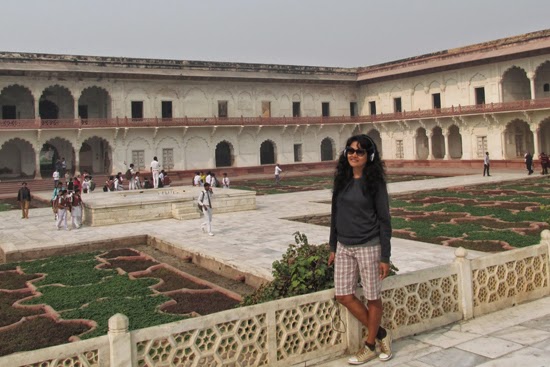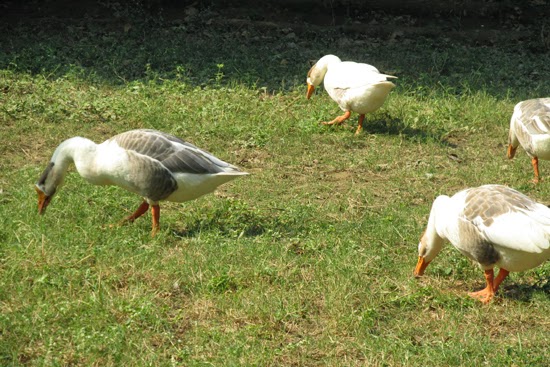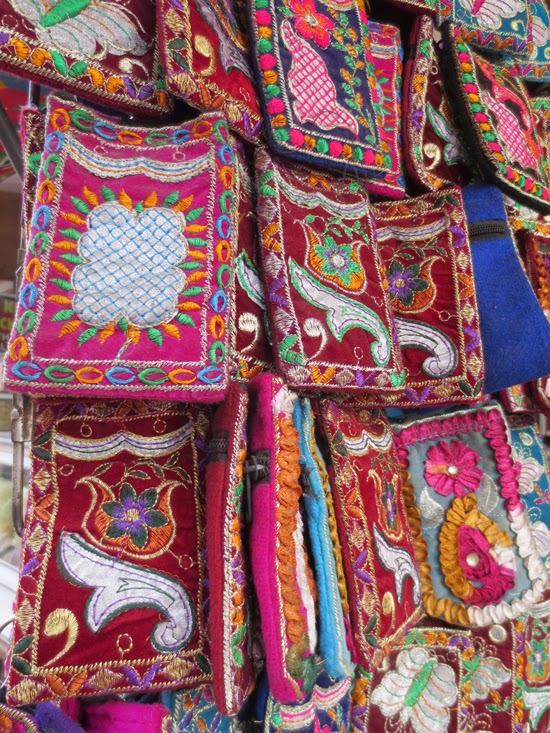Agra! yes, this is the next stop... staying here for 4 days, and trust me... I can go on and on and on about a place and the monument. Reading the Lonely Planet, Photographic Encyclopedia and history books about the place and start to see with my own eyes.... Here goes narrowed down (waaaaayyy down) photos from my Agra trip.
Agra Fort is about 2.5 km northwest of its more famous
sister monument, the Taj Mahal. The fort can be more accurately described as a
walled city. The present-day structure was built by the Mughals, though a fort
had stood there since at least the 11th century. Agra Fort was originally a
brick fort known as Badalgarh, held by Raja Badal Singh Hindu Sikarwar Rajput
king (c.1475).
- mentioned for the first time in 1080 AD when a Ghaznavide
force captured it.
- after the First Battle of Panipat in 1526, Mughals captured
the fort and seized a vast treasure, including the diamond later known as the
Koh-i-Noor.
- the emperor Humayun was crowned here in 1530.
- Humayun was
defeated at Bilgram in 1540 by Sher Shah
- fort remained with Suris till
1555, when Humanyun recaptured it.
- the Hindu king Hem Chandra Vikramaditya (also called 'Hemu') defeated Humanyun's army.
- Hemu got a huge booty from this
fort and went on to capture Delhi from the Mughals. The Mughals under Akbar
defeated King Hemu finally at the Second Battle of Panipat in 1556.
It was only during the reign of Akbar's grandson, Shah
Jahan, that the site took on its current state. Legend has it that Shah Jahan
built the beautiful Taj Mahal for his wife, Mumtaz Mahal. Unlike his
grandfather, Shah Jahan tended to have buildings made from white marble, often
inlaid with gold or semi-precious gems*.
*see below technique
- the fort was invaded by the Maratha Empire during the mid
18th century.
- catastrophic defeat at Third Battle of Panipat by Ahmad
Shah Abdali in 1761, Marathas remained out of the region for the next decade.
- finally Mahadji Shinde took the fort in 1785.
- lost by the Marathas to
the British during the Second Anglo-Maratha War, in 1803.
- fort was the site of a battle during the Indian
rebellion of 1857, which caused the end of the British East India Company's
rule in India, and led to a century of direct rule of India by Britain.
###
Sikandra, the tomb of Akbar the Great is an important
Mughal architectural masterpiece, built 1605–1613, set in 48 Ha (119 acres) of
grounds in Sikandra, a suburb of Agra.
The third Mughal Emperor Akbar the Great (1555–1605),
himself commenced its construction in around 1600, according to Tartary
tradition to commence the construction of one's tomb during one's lifetime.
Akbar himself planned his own tomb and selected a suitable site for it. After
his death, Akbar's son Jahangir completed the construction in 1605-1613. Akbar
was one of the greatest emperors in the history of India.
###
Yes, we've been to 2 Gurudwara since we've been in India.
This 3rd one is Guru ka Taal; a historical Sikh pilgrimage place dedicated to
the memory of ninth Guru Sri Guru Tegh Bahudar Ji. The Gurudwara was built over
the place where the Guru Tegh Bahadur laid down his arms to offer arrest to
Aurangazeb, the Mughal Emperor. Several devotees gather every year to pay
homage to the great Sikh guru in this Gurudwara. This historic structure dates
back to the 17th century. Earlier it was a Taal (reservoir) in the area near
Sikandra. It was built in 1610 AD to collect and conserve rainwater in Agra
during Jehangir reign. The water of the reservoir was used for irrigation
purposes during the dry season. The reservoir was ornamented with stone
carvings. This is said to be the place where the Guru Tegh Bahadur laid down
his arms to offer arrest to Aurangazeb.
###
The backpart of Taj Mahal seen from Meghtab Bagh
It was a Friday and Taj Mahal was closed, so we opted to do a day tour around Agra Fort, Gurudwara, etc. and planned for Taj Mahal the next morning when sunrise...
Mehtab Bagh (Moonlight Garden) is a charbagh complex that
lies north of the Taj Mahal complex and the Agra Fort --on the opposite side of
the Yamuna River. The garden complex, square in shape, measures about 300 by
300 metres and is perfectly aligned with the Taj Mahal on the opposite bank.
During the rainy season, the ground becomes partially flooded. It is also noted
that Emperor Shah Jahan had identified a site from the crescent-shaped,
grass-covered floodplain across the Yamuna River as an ideal location for
viewing the Taj Mahal. It was then created as "a moonlit pleasure garden
called Mehtab Bagh." Frequent floods and villagers extracting building
materials nearly ruined the garden. Remaining structures within the garden were
in a ruinous state. The garden's existence was almost forgotten and it had
degraded to little more than an enormous mound of sand, covered with wild
vegetation and alluvial silt.
yes, its cow-dung cake...
###
*white marble inlaid with semi-precious gems technique, same as the Taj Mahal walls / decors
###
Nehru Park
###
###
Chini ka Rauza is a funerary monument, rauza in Agra,
India, containing the tomb of Allama Afzal Khan Mullah, a scholar and poet who
was the Prime Minister of the Mughal Emperor Shah Jahan.
Behind part of Chini Ka Rauza
cow dung factory
###
Itmad-Ud Daulla (Baby Taj)
Tomb of Itmad-Ud Daulla is a Mughal mausoleum often
described as a "jewel box", sometimes called the "Baby
Tāj", the tomb of Itmad-Ud Daulla is often regarded as a draft of the
Tāj Mahal. The mausoleum was commissioned by Nūr Jahān, the wife of Jahangir, for
her father Mirzā Ghiyās Beg, originally a Persian Amir in exile, who had been
given the title of I'timād-ud-Daulah (pillar of the state). Mirzā Ghiyās Beg
was also the grandfather of Mumtāz Mahāl (originally named Arjūmand Bāno,
daughter of Asaf Khān), the wife of the emperor Shāh Jahān, responsible for the
construction of the Tāj Mahal.
###
dun dun dun.....
The Taj Mahal "crown of palaces", is a white marble mausoleum. It was built by Mughal emperor Shah Jahan in memory of his third wife, Mumtaz Mahal. The Taj Mahal is widely recognized as "the jewel of Muslim art in India and one of the universally admired masterpieces of the world's heritage". Taj Mahal is regarded by many as the finest example of Mughal architecture, a style that combines elements from Islamic, Persian, Ottoman Turkish and Indian architectural styles.
In 1631, Shah Jahan, emperor during the Mughal empire's period of greatest prosperity, was grief-stricken when his third wife, Mumtaz Mahal, a Persian princess, died during the birth of their 14th child, Gauhara Begum. The court chronicles of Shah Jahan's grief illustrate the love story traditionally held as an inspiration for Taj Mahal. The principal mausoleum was completed in 1648 and the surrounding buildings and garden were finished five years later. Emperor Shah Jahan himself described the Taj in these words:
"Should guilty seek asylum here,
Like one pardoned, he becomes free from sin.
Should a sinner make his way to this mansion,
All his past sins are to be washed away.
The sight of this mansion creates sorrowing sighs;
And the sun and the moon shed tears from their eyes.
In this world this edifice has been made;
To display thereby the creator's glory."
###
and now... the bazaar...
Kinari Bazaar
Jama Masjid
thank you all for stopping by and viewing the post...
I hope you enjoyed the pictures here...
xxx























































































